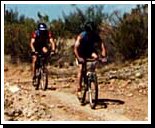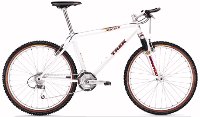
Mountain Biking
About Mountain Bikes
 |
A Window on ... Mountain Biking About Mountain Bikes |
The Mountain Bike In any shop you will see a range of bikes at various prices. Some are designed for a lot of road use, others are better suited for rough ground. Your choice of bike will depend on many things - the type of riding you want to do, the features you want on your bike and probably the cost. All good mountain bikes are stable, safe and strong.
In any shop you will see a range of bikes at various prices. Some are designed for a lot of road use, others are better suited for rough ground. Your choice of bike will depend on many things - the type of riding you want to do, the features you want on your bike and probably the cost. All good mountain bikes are stable, safe and strong.
Frames Many frames are made of steel or steel alloys (look for the labelling on the tubes). The most common steel alloy is cro-mo. Lighter steel alloys such as manganese molybdenum are used on more expensive bikes and the top-of-the range bikes use aerodynamic tubing with carbon fibre. Aluminium tubing for frames is becoming more popular but as aluminium is not as strong as steel, the tubes are made fatter to increase their strength. Handlebars are usually made of steel or aluminium. They are wider than those on a normal bike to give good control when steering. Most bikes have 26 in-diameter wheels although small models may have 24 in-wheels. These wheels are very strong and should be made of aluminium alloy rather than steel to help the brake pads grip better. Toe clips on the pedals are useful, especially for off-road riding.
Gears Derailleur gears use cables that stretch with use. These can be tightened when necessary by turning the cable adjusting barrel (most systems have one). The gears on a mountain bike help you to ride up steep hills and over rough ground reasonably easily - providing you are fit!
Brakes Nearly all mountain bikes have cantilever front brakes that are excellent for stopping the bike. More powerful braking systems are often fitted as rear brakes. The brakes are controlled by levers on the handlebars.
Tyres
Saddle
| ||||||||||||
CostThe cost of a bike can vary from around £150 up to £5,000 for a top of the range, custom-built model. You may see special offers and reductions advertised in some shops but you should check these out carefully. (See Buying a bike below).
| ||||||||||||
Buying a bike Although your choice may be limited to how much you can afford, what you really should be looking for is a bike that suits you. Look for the basics when buying a bike - the right size, good quality, the materials used for the frame, brakes and wheels, safety features and ease of handling. Don't be attracted just by the extra gadgets on offer - these may only add superficial glamour.
Size
Cost You should also be wary of buying a second hand mountain bike as a cheap option unless you are sure you know what to look for in terms of safety and reliability. Check out the tyres, brakes and gears, and look for wear and tear on the frame. Always ask for a test ride to make sure everything works and the bike is comfortable.
Other features
| ||||||||||||
| ||||||||||||
|
| ||||||||||||